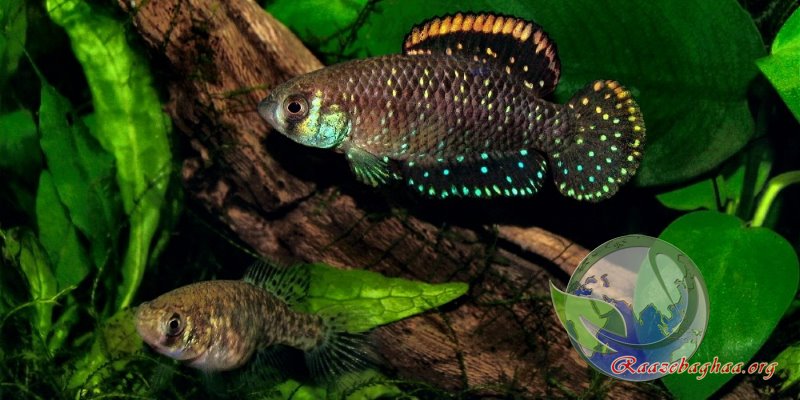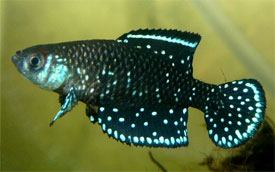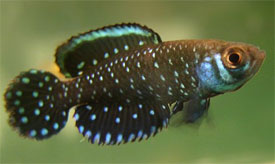
Austrolebias nigripinnis
FAMILY
Rivulidae
TAXONOMY
Austrolebias nigripinnis Regan, 1912, La Plata, Argentina.
OTHER COMMON NAMES
Vernacular: Nigripinnis.
PHYSICAL CHARACTERISTICS
A small species, 2–2.75 in (5–7 cm) and rarely more than 2 in
(5 cm) long. Relatively deep-bodied and sexually dimorphic
and dichromatic. Males are larger than females. All fins are
blue-black with an iridescent greenish overlay on the pectorals.
Fins are rounded, with relatively large anal and dorsal fin
bases. Iridescent metallic-green margin on the dorsal fin and
similar margins on the anal and caudal fins are made up of a
series of separate spots. Opalescent whitish to greenish spots
on all fins and the body, forming five to 11 vertical bars. Lines
paralleling the fin edges on the unpaired fins. Body color is
sometimes pale around the abdomen. All intensities and patterns
vary widely. The female has smaller rounded fins and
brown mottling on the body, dorsal fin, and anal fin. Clear
caudal, ventral, and pectoral fins and whitish abdominal area.
DISTRIBUTION
The La Plata River basin in Uruguay and Argentina.
HABITAT
Inhabit temporary waters, such as flooded meadows, shallow
ponds, and roadside ditches.
BEHAVIOR
The male takes over an area, which it defends against other
males. A female moves in, signaling her receptivity by tilting
toward the substrate. The male joins the female, and they
move side by side with their heads together. The pair spawns
directly on the substrate or, conditions permitting, by diving
into it. In an aquarium with more than one male, a dominant
male, obvious by his black body and fins, defends a spawning
area of his choice; the color of the other males fades to light
gray, with some black or brownish blotching. If the aquarium
is heavily planted so that the males cannot see each other,
more than one dominant male may appear.
FEEDING ECOLOGY AND DIET
The species feeds on live foods, such as aquatic and terrestrial
insects, worms, crustaceans, and other aquatic invertebrates. In
aquaria live foods (such as fruit flies, brine shrimp, chironomid
larvae, tubificid worms, and daphnia) are accepted eagerly and
almost everything else is rejected, with the exception of
chopped earthworms and certain paste foods.
REPRODUCTIVE BIOLOGY
Eggs placed in the substrate during spawning go into diapause.
When the temporary waters evaporate, the adults die off, but
the eggs survive until they hatch in the next rainy season,
within hours of being wetted. Aquarists simulate this environment
by providing garden peat moss as the substrate, periodically
collecting the peat and storing it away in an almost dry
state at a temperature of about 70°F (20°C). When the peat is
flooded after two to four months of storage, most of the eggs
will hatch. If the eggs do not hatch, the peat can be dried
again and flooded at a later date.
CONSERVATION STATUS
Not listed by the IUCN.
SIGNIFICANCE TO HUMANS
The blackfin pearl killifish is exchanged among aquarium
hobbyists but only rarely becomes available in the aquarium
trade.
Other popular Animals
Photo Gallery of - Blackfin pearl killifish





 Animalia Life
Animalia Life